Diesel Exhaust Particulate Filter
Purpose and Function
Diesel exhaust particulate filters (DPFs) are used in all light-duty diesel vehicles, since 2007, to meet the exhaust emissions standards. The heated exhaust gas from the DOC flows into the DPF, which captures diesel exhaust gas particulates (soot) to prevent them from being released into the atmosphere. This is done by forcing the exhaust through a porous cell which has a silicon carbide substrate with honeycomb-cell-type channels that trap the soot.
The main difference between the DPF and a typical catalyst filter is that the entrance to every other cell channel in the DPF substrate is blocked at one end. So instead of flowing directly through the channels, the exhaust gas is forced through the porous walls of the blocked channels and exits through the adjacent open-ended channels. This type of filter is also referred to as a “wall-flow” filter.
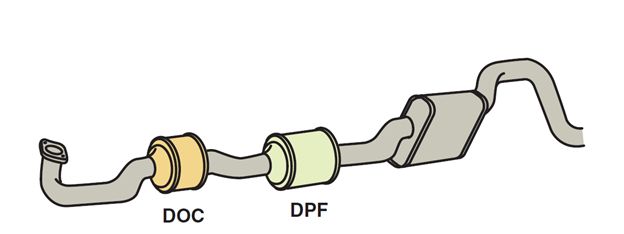
Diesel Oxidation Catalyst and Diesel Exhaust Particulate Filters Handle Diesel Exhaust
Operation
Soot particulates in the gas remain trapped on the DPF channel walls where, over time, the trapped particulate matter will begin to clog the filter. The filter must therefore be purged periodically to remove accumulated soot particles. The process of purging soot from the DPF is described as regeneration. When the temperature of the exhaust gas is increased, the heat incinerates the soot particles trapped in the filter and is effectively renewed.
Exhaust Gas Temperature Sensors

EGT 1 and EGT2 are used by the PCM to help control after treatment
The following two exhaust gas temperature sensors are used to help the PCM control the DPF.
- EGT sensor 1 is positioned between the DOC and the DPF where it can measure the temperature of the exhaust gas entering the DPF.
- EGT sensor 2 measures the temperature of the exhaust gas stream immediately after it exits the DPF.
The powertrain control module monitors the signals from the EGT sensors as part of its calibrations to control DPF regeneration. Proper exhaust gas temperatures at the inlet of the DPF are crucial for proper operation and for starting the regeneration process. Too high a temperature at the DPF will cause the DPF substrate to melt or crack. Regeneration will be terminated at temperatures above 1,470°F (800°C). With too low a temperature, self-regeneration will not fully complete the soot-burning process.
DPF Differential Pressure Sensor
The DPF differential pressure sensor (DPS) has two pressure sample lines.
- One line is attached before the DPF.
- The other is located after the DPF.
The exact location of the DPS varies by vehicle model type such as medium duty, pickup, or van. By measuring the exhaust supply (upstream) pressure from the DOC, and the post DPF (downstream) pressure, the PCM can determine differential pressure, also called “delta” pressure, across the DPF. Data from the DPF differential pressure sensor is used by the PCM to calibrate for controlling DPF exhaust system operation.
Diesel Particulate Filter Regeneration
The primary reason for soot removal is to prevent the buildup of exhaust back pressure. Excessive back pressure increases fuel consumption, reduces power output, and can potentially cause engine damage. Several factors can trigger the diesel PCM to perform regeneration, including:
- Distance since last DPF regeneration
- Fuel used since last DPF regeneration
- Engine run time since last DPF regeneration
- Exhaust differential pressure across the DPF
DPF Regeneration Process
A number of engine components are required to function together for the regeneration process to be performed, as follows:
- PCM controls that impact DPF regeneration include late post injections, engine speed, and adjusting fuel pressure.
- Adding late post injection pulses provides the engine with additional fuel to be oxidized in the DOC, which increases exhaust temperatures entering the DPF to 900°F (500°C) or higher.
- The intake air valve acts as a restrictor that reduces air entry to the engine, which increases engine operating temperature.
- The intake air heater may also be activated to warm intake air during regeneration.
Types of DPF Regeneration

Regeneration burns the soot and renews the Diesel Exhaust Particulate Filter
DPF regeneration can be initiated in a number of ways, depending on the vehicle application and operating circumstances. The two main regeneration types are as follows:
- Passive regeneration. During normal vehicle operation when driving conditions produce sufficient load and exhaust temperatures, passive DPF regeneration may occur. This passive regeneration occurs without input from the PCM or the driver. A passive regeneration may typically occur while the vehicle is being driven at highway speed or towing a trailer.
- Active regeneration. Active regeneration is commanded by the PCM when it determines that the DPF requires it to remove excess soot buildup and conditions for filter regeneration have been met. Active regeneration is usually not noticeable to the driver. The vehicle needs to be driven at speeds above 30 mph for approximately 20 to 30 minutes to complete a full regeneration. During regeneration, the exhaust gases reach temperatures above 1,000°F (550°C). Active regeneration is usually not noticeable to the driver.
Ash Loading
Regeneration will not burn off ash. Only the particulate matter (PM) is burned off during regeneration. Ash is a noncombustible by-product from normal oil consumption. Ash accumulation in the DPF will eventually cause a restriction in the particulate filter. To service an ash-loaded DPF, the DPF will need to be removed from the vehicle and cleaned or replaced. Low ash content engine oil (API CJ-4) is required for vehicles with the DPF system. The CJ-4 rated oil is limited to 1% ash content.
Next Steps towards ASE Certification
Now that you’re familiar with Exhaust Gas Filtration, Regeneration, and Conversion, try out our free Automotive Service Excellence Tests to see how much you know!
![ASE Certification Training HQ - Free ASE Practice Tests [Updated 2021]](https://asecertificationtraining.com/wp-content/themes/simplefolio/images/ASE Certification Logo.png)

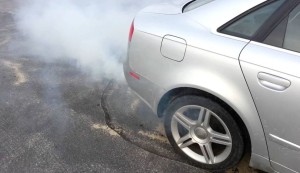
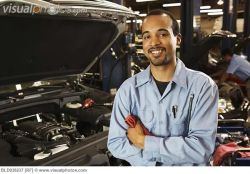 automotive technicians choose to acquire special certification from the National Institute for Automotive
automotive technicians choose to acquire special certification from the National Institute for Automotive 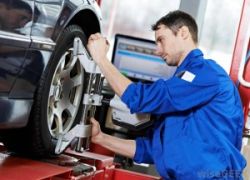 to Service: Auto service techs help potential customers regularly, and the best mechanics cultivate special personalised relationships with their clientele that keep them coming back for potential future Assistance. A number of technicians underrate this aspect of the Alaska automotive repair marketplace.
to Service: Auto service techs help potential customers regularly, and the best mechanics cultivate special personalised relationships with their clientele that keep them coming back for potential future Assistance. A number of technicians underrate this aspect of the Alaska automotive repair marketplace.


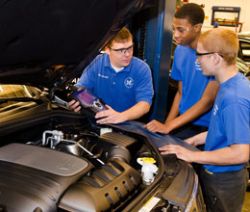 number of mechanics decide to obtain extra qualification from the National Institute for Automotive Service Excellence (ASE) (www.ase.com). ASE is an independent, non-profit organization that improves the the effectiveness of vehicle
number of mechanics decide to obtain extra qualification from the National Institute for Automotive Service Excellence (ASE) (www.ase.com). ASE is an independent, non-profit organization that improves the the effectiveness of vehicle 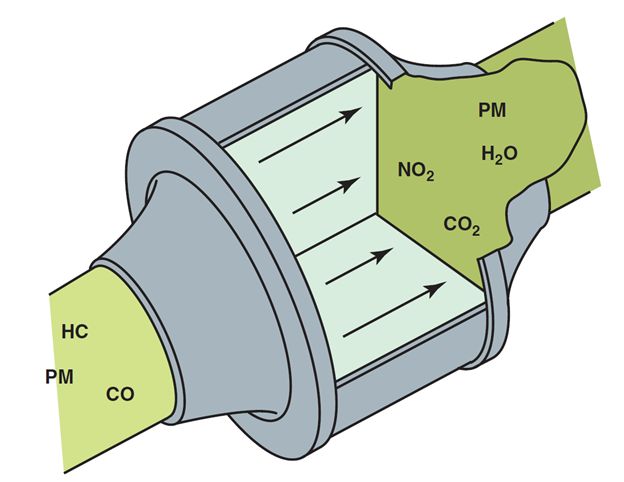

 to Detail: Automotive issues can regularly times be caused by disregarded details or circumstances that can be caught by a extremely detail-oriented mechanic. The nature of an car specialist is to go over every plausible challenge with great depth when reaching a prognosis or repair.
to Detail: Automotive issues can regularly times be caused by disregarded details or circumstances that can be caught by a extremely detail-oriented mechanic. The nature of an car specialist is to go over every plausible challenge with great depth when reaching a prognosis or repair. automotive technicians decide to acquire valuable qualification from the National Institute for Automotive Service Excellence (ASE) (www.ase.com). ASE is an private, non-profit institution that works to improve the level of quality of car or truck maintenance and service by certifying and testing repair work and auto service trained professionals. ASE Certification is definitely a significant component to a technician’s experience and resume, and can help showcase ability and make applicants much more marketable to future hiring managers. Simply make sure to put in some time to study for the tests by using our completely free testing resources and test questions. Automotive mechanics along with other auto service professionals that want to get ASE certification can take a few of ASE’s 40 exams. After passing these job-related ability tests, the technician becomes ASE certified in any one of the following subjects: medium/heavy truck, truck, collision repair, and more.
automotive technicians decide to acquire valuable qualification from the National Institute for Automotive Service Excellence (ASE) (www.ase.com). ASE is an private, non-profit institution that works to improve the level of quality of car or truck maintenance and service by certifying and testing repair work and auto service trained professionals. ASE Certification is definitely a significant component to a technician’s experience and resume, and can help showcase ability and make applicants much more marketable to future hiring managers. Simply make sure to put in some time to study for the tests by using our completely free testing resources and test questions. Automotive mechanics along with other auto service professionals that want to get ASE certification can take a few of ASE’s 40 exams. After passing these job-related ability tests, the technician becomes ASE certified in any one of the following subjects: medium/heavy truck, truck, collision repair, and more.
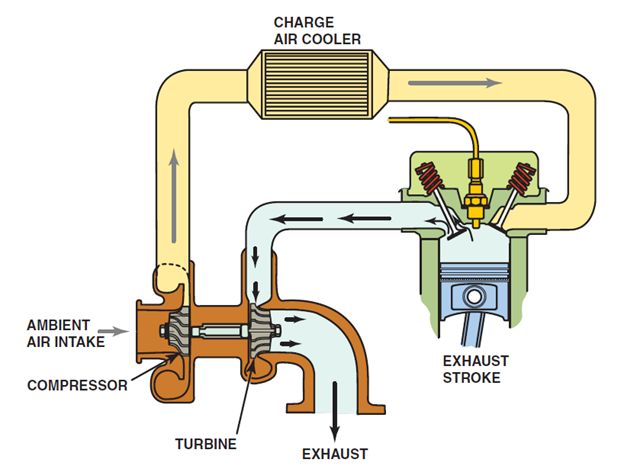
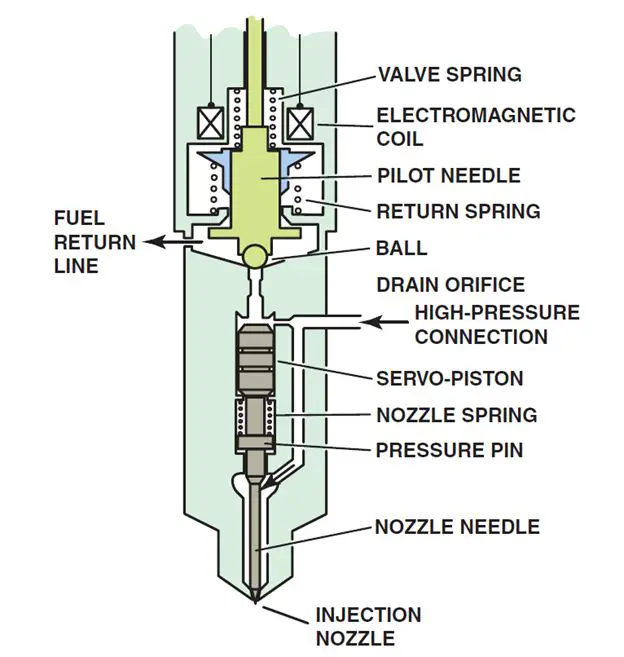
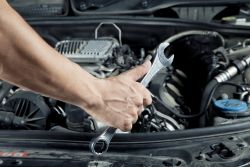 Environmental Protection Agency (EPA) calls for all vehicle professionals that work with or buy refrigerants to have certification in suitable handling of refrigerants. Currently there is not a formalised examination preparation necessary, but several labor unions, technical schools, and company groups offer training and seminars for examination preparation. More information about this official certification can be found at the official EPA website.
Environmental Protection Agency (EPA) calls for all vehicle professionals that work with or buy refrigerants to have certification in suitable handling of refrigerants. Currently there is not a formalised examination preparation necessary, but several labor unions, technical schools, and company groups offer training and seminars for examination preparation. More information about this official certification can be found at the official EPA website.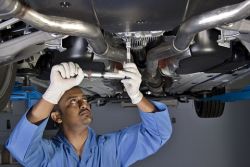 Customer Service Background: Automotive service mechanics work with potential customers regularly, and the greatest mechanics develop close personal connections with their clientele that keep them returning for possible future Assistance. A number of technicians undervalue this part of the Montana auto repair service marketplace.
Customer Service Background: Automotive service mechanics work with potential customers regularly, and the greatest mechanics develop close personal connections with their clientele that keep them returning for possible future Assistance. A number of technicians undervalue this part of the Montana auto repair service marketplace.